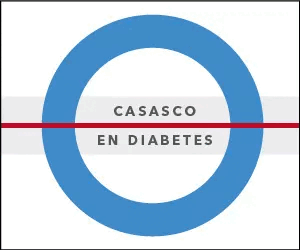P27 Prevalence of microvascular dysfunction in diabetic patients with normal gated spect
DOI:
https://doi.org/10.47196/diab.v54i3Sup.411Keywords:
microvascular dysfunction, type 1 and 2 diabetes, normal GATED-SPECTAbstract
Introduction: Patients with diabetes have an increased risk for cardiovascular events. Microvascular dysfunction is an early sign of damage, associated with poorer prognosis in these patients, including those with normal gated SPECT.
Objective: The aim of this study was to assess the prevalence of microvascular dysfunction according to the type of diabetes through quantification of coronary flow reserve (CFR) in patients with normal gated SPECT.
Materials and methods: Patients included in the study had diabetes without known history of coronary disease, without perfusión defects in c99-MIBI gated SPECT and preserved ventricular function. CFR was calculated by means of peak/resting coronary flow velocity ratio after dipyridamole with 4DM®-SPECT software with cadmium zinc telluride detectors (CZT-SPECT). CFR < 2 was considered to be microvascular dysfunction, and CFR < 1.6 was regarded as severe dysfunction.
Results: 101 patients were included in the study. Patients with type 1 diabetes (DM1) were younger, with a longer time of evolution of diabetes and worse glycemic control than patients with type 2 diabetes (DM2). Prevalence of microvascular dysfunction was 38.8% in DM1 patients and 49.3 % in DM2 patients (p: ns ). The prevalence of severe
microvascular dysfuntion was 14.2 % in DM1 patients and 17.9 % in DM2 (p: ns). Patients with microvascular dysfunction were older and had a higher prevalence of other microvascular complications (nephropathy, retinopathy or neuropathy).
Conclusions: There is a high prevalence of microvascular dysfunction in patients with diabetes and normal gated SPECT regardless of the type of diabetes. Its identification might be useful to guide future treatments.
Downloads
Published
How to Cite
Issue
Section
License

This work is licensed under a Creative Commons Attribution-NonCommercial-NoDerivatives 4.0 International License.
Dirección Nacional de Derecho de Autor, Exp. N° 5.333.129. Instituto Nacional de la Propiedad Industrial, Marca «Revista de la Sociedad Argentina de Diabetes - Asociación Civil» N° de concesión 2.605.405 y N° de disposición 1.404/13.
La Revista de la SAD está licenciada bajo Licencia Creative Commons Atribución – No Comercial – Sin Obra Derivada 4.0 Internacional.
Por otra parte, la Revista SAD permite que los autores mantengan los derechos de autor sin restricciones.

































